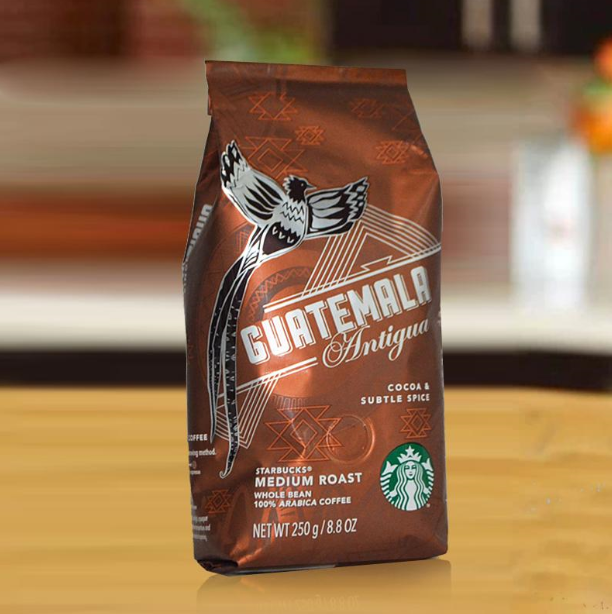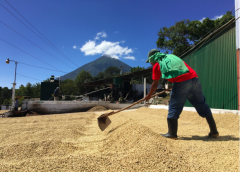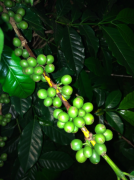Starbucks Guatemala Antigua Coffee Guatemalan Vivette Nango from Central America
For professional baristas, please follow the coffee workshop (Wechat official account cafe_style)
This is an elegant, rich and deep coffee, its delicate acidity is perfectly balanced with subtle cocoa texture and soft spice flavor.
Origin: Latin America
Processing method: washing method
Flavor: cocoa, spice
Acidity: medium
Alcohol: medium
Food matching suggestions: cocoa, apples, caramel, nuts
Similar to coffee: coffee of choice

The Ya civilization is well known for predicting the end of the world in 2012, and Guatemala was one of the Mayan settlements as early as 2500 BC, so Guatemala was also one of the centers of ancient Indian Mayan culture. Of course, the Mayan civilization and the Mayans are not the theme of this article. What I want to know with you this time is that there is another crystallization in the land of wisdom that gave birth to the Mayan civilization: the coffee of Guatemala.
Guatemala is a presidential republic in Central America, located in the south of the North American continent. It is bordered by the Pacific Ocean to the west, the Caribbean Sea to the east, Mexico to the north and Honduras and El Salvador to the southeast. Coffee was really introduced into Guatemala in 1750 by Father Jesuit, and the coffee industry was developed by German colonists at the end of the 19th century.
Guatemala covers an area of about 108899 square kilometers. The land features can be divided into plateau volcanoes, lowland tropical forests, volcanic sandy shore plains along the Pacific coast, and virgin lands along the Caribbean Sea. The SierraMadre Mountains of Central America, which straddles Guatemala from east to west, covers an area of about 2GP3 and has 34 volcanoes. In this country, rivers and lakes dot the landscape, while equatorial forests and plain jungles cover the land. Today, most of the coffee industry's production takes place in the south of the country and is rich in high-quality coffee beans.
This is because Guatemala is located in the tropics, the northern and eastern coastal plains have a tropical rain forest climate, and the southern mountains have a subtropical climate, with two dry and wet seasons a year, with the wet season from May to October and the dry season from November to April of the following year.
The central plateau is also the cultural center of Guatemala, where temperatures are mild all year round at an altitude of 1300 to 1800 meters, with daily temperatures between 18 and 28 ℃, and higher levels tend to be colder in January and February. The annual precipitation is 2000-3000 mm in the northeast and 500-1000 mm in the south, while the ecological conditions in the south are very suitable for the growth of high-quality Arabica trees. What is more special is that several active volcanoes are distributed in the southern mountains, and these active volcanoes still erupt irregularly. Although they bring instability to the lives of the local people, their rich volcanic ash soil also benefits the local coffee industry and brings rich substances to coffee cultivation.
And most of the Guatemalan coffee beans belong to the bourbon species of Arabica, so almost all of Guatemala's coffee-growing areas are in the southern mountain forests of the country.
In Guatemala, there are seven major coffee producing areas, each producing different coffee flavors, but to sum up, Guatemalan coffee shows a mild and mellow overall texture, elegant aroma, and similar acidity and pleasant acidity, becoming the aristocracy of coffee, among which AntiguaClassic in Antigua is highly recommended by coffee gluttons all over the world.
Antigua is the oldest and most beautiful city in America. As early as 1543, Antigua was the capital of all colonial times in Central America, and the Government House of Spain was also set up here. After the great earthquake of 1773, the volcano destroyed the once-prosperous capital in an instant, robbing it of all its prosperity and beauty overnight. The whole city of Antigua was destroyed, so the capital was moved to Guatemala City. After this subversive mountain city, the splendor has disappeared for more than 200 years, and Antigua has never swaggered again. After being dull, Antigua is now run by the last remaining Indians. These hardworking Indians became later coffee producers. They not only discovered the rich and attractive unique smell of Antigua coffee, but also brought it to people all over the world.
Antigua is now a famous producer of coffee. Rich volcanic soil, low humidity, strong sunlight and cool night breezes are the characteristics of Antigua. Three spectacular active volcanoes ── Agua, Acatenango and Fuego form a beautiful valley. Fuego active volcano also adds misty dust from time to time. Every 30 years or so, the area near Antigua is hit by a volcanic eruption, which provides more nitrogen to the already fertile land, and plenty of rainfall and sunlight make the place more suitable for growing coffee.
Important Notice :
前街咖啡 FrontStreet Coffee has moved to new addredd:
FrontStreet Coffee Address: 315,Donghua East Road,GuangZhou
Tel:020 38364473
- Prev

Fredy Guarchaj Manor Santa Clara, Guatemala introduces the coffee producing area of Lake Attila
For the exchange of professional baristas, please follow the Coffee Workshop (Wechat official account cafe_style) Santa Clara Fredy Guarchaj Manor Santa Clara this beautiful city is located on high-altitude hilly slopes, extending from 1500 meters above sea level to 2000 meters above sea level on Lake Attilan. Lake Attilan, which covers an area of 130.1 square kilometers, is the largest inland lake in Guatemala.
- Next

Finca El Naranjo of Manor Orange City, Guatemala introduces the original bourbon species of Guatemala.
The exchange of professional baristas please follow the Coffee Workshop (Wechat official account cafe_style) Orange City Manor introduction Orange City Manor is a treasure from Guatemala City (now the capital of Guatemala). The cultivation of coffee has long been extinct in Guatemala City, and after the economic take-off, the city is now commercially developed and full of buildings. However, the hilltop where the Orange City Manor is located, because
Related
- Detailed explanation of Jadeite planting Land in Panamanian Jadeite Manor introduction to the grading system of Jadeite competitive bidding, Red bid, Green bid and Rose Summer
- Story of Coffee planting in Brenka region of Costa Rica Stonehenge Manor anaerobic heavy honey treatment of flavor mouth
- What's on the barrel of Blue Mountain Coffee beans?
- Can American coffee also pull flowers? How to use hot American style to pull out a good-looking pattern?
- Can you make a cold extract with coffee beans? What is the right proportion for cold-extracted coffee formula?
- Indonesian PWN Gold Mandrine Coffee Origin Features Flavor How to Chong? Mandolin coffee is American.
- A brief introduction to the flavor characteristics of Brazilian yellow bourbon coffee beans
- What is the effect of different water quality on the flavor of cold-extracted coffee? What kind of water is best for brewing coffee?
- Why do you think of Rose Summer whenever you mention Panamanian coffee?
- Introduction to the characteristics of authentic blue mountain coffee bean producing areas? What is the CIB Coffee Authority in Jamaica?

